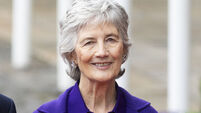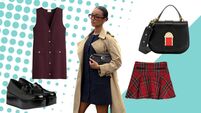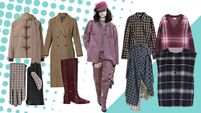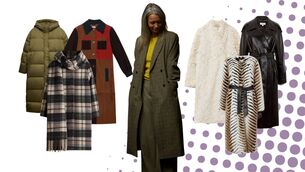Vintage fashion reigns supreme

FROM the valleys of North Wales to the rarified ateliers of haute couture is quite a journey but it is a transition that Kerry Taylor, a leading expert on vintage fashion and couture has executed in her typically understated yet determined style. As Sotheby’s youngest auctioneer (at the age of 21) and subsequently as Kerry Taylor Auctions, she has handled an amazing variety of historical garments as the UK’s premier vintage auctioneer. She has sold pieces that belonged to royals (Princess Diana and the Duke and Duchess of Windsor), Hollywood superstars (Audrey Hepburn, Liz Taylor and Marilyn Monroe), aristocratic society princesses (the Honourable Daphne Guinness), supermodels (Marie Helvin and Jerry Hall) and rock royalty (Michael Jackson).
Her clients include museums, private collectors, fashion houses, fashion and costume designers, and women who buy vintage to wear themselves. One of her well-known Irish clients is the Newbridge Museum of Style Icons who has bought Princess Diana’s wedding dress toile (£17,000), the lavishly embroidered Catherine Walker evening ensemble Diana wore on her state visit to India in 1982 (£55,000) and a bustled Balenciaga cloqué gown worn by Ava Gardner (£11,000). Kerry has glowing praise for William Doyle, the owner of Newbridge, whom she credits with bringing “glamour and sparkle to Ireland”.
For Kerry, growing up in Wales there wasn’t much immediate glamour, but she was besotted with black and white movies and the designs of golden era costume designers. A fashion fanatic since the age of 10, she saved up to buy her first piece of vintage, a sequined 1930s capelet from a local second hand shop. When she took up a position with Sotheby’s Chester office she vividly remembers being “awe inspired” by the first flapper dress she handled. Such was her success in Chester she was invited to join Sotheby’s New Bond St branch and her career in vintage fashion took off.
Her first costume auction in Sotheby’s New Bond St featured a Black Rod of Ireland cut velvet suit that sold to the Ulster Museum for £18,500. It was a major coup for Kerry but it was vintage 20th century fashion, in particular haute couture, which became her defining passion. She identifies vintage as “a garment that possesses age, beauty and great design”, elaborating that “much of what is described as vintage today is just second hand clothing and the vintage tag just an excuse for overcharging”. She also makes a clear distinction between haute couture and designer ready-to-wear: “Haute couture is the highest form of fashion excellence in its design, fabric and execution.”
She explains that in the 1950s, the money went into the clothes and not the marketing, or the building of a brand. For her much contemporary fashion is “not well made, mass produced, and is sold to those trying to get a little bit of the magic” rather than clients who have an appreciation of cut and finish. When she looks inside a garment she is eagle eyed about finish and condition, examining for raw edges, the state of the armpit, tears and the designer’s label which can be hidden in the waistline, side-seams or even the under-slip. While minor alterations such as hemline adjustments aren’t the end of the world, dramatic alterations will diminish the price accordingly.
At the start of Kerry’s career vintage fashion was a niche sector with a limited clientele, but “from 2000 on life got a lot easier” with stars such as Julia Roberts favouring vintage on the red carpet and the stylish and slightly alternative model, Kate Moss showing how vintage could look distinctive and desirable when styled with a contemporary twist.
Kerry observes, “with no strong look or trends now and many fashions derivative of earlier vintage” genuine vintage clothing is “good value for money, exceptional, one off and very attractive”. The only downside is sizing as a typical 1970s garment might now only fit a contemporary teenager. Kerry wryly acknowledges that it is akin to being like somebody in a sweet shop as many of the most desirable pieces are very tiny. She mentions a Sybil Connolly evening dress owned by Anne Bullit in the Newbridge Museum of Style Icons that has a 21” waist — a rarity these days.
As someone who has handled so much stunning fashion, it is notable that Kerry lists three garments with royal connections as her most memorable sales: a King James II 17th century lace wedding suit, Princess Diana’s strapless black Catherine Walker evening dress worn on her first public engagement with Charles (£160,000) and Kate Middletons’ sheer knit tube dress from the fashion show where she caught Prince William’s eye (£78,000). In a purely fashion context she cites an Elsa Schiaparelli Zodiac jacket from her most recent auction that fetched £132,000 as very special.
A celebrity owner can add at least one if not two zeros to the price of a garment. Kerry acknowledges that the cult of celebrity has become almost a “horrible new religion” with some buyers worshipping deceased stars to a degree that is “creepy”. For such collectors the presence of a celebrity’s DNA on a garment is an essential part of the purchase and dry cleaning will reduce the value. This is especially true of iconic celebrities such as Princess Diana and Marilyn Monroe. For Kerry, her favourite celebrity collection was that of Audrey Hepburn, whom she describes as a “most incredibly beautiful human being, inside and out”. This quality combined with her exquisite Givenchy Haute Couture made it a rare experience.
Pushing Kerry to pick her favourite fashion decade is hard but when pressed she identifies the 1950s as it was the “Golden Age of haute couture” when women dressed like ladies and designers such as Givenchy, Dior, Balmain and Balenciaga created beautiful elegant garments. She also explains that at that time haute couture was still relatively affordable and women, including professionals and doctors’ wives, could rise to the luxury of made-to-measure fashions. In comparison to the price of contemporary haute couture, pieces then could be bought for hundreds of pounds.
She is fascinated by the special relationship women, especially famous women, have with their clothing, noting how Audrey Hepburn said that her Givenchy was her “suit of armour” and that she felt “protected” in it.
Deciding to part with a lifetime’s worth of fashion can be prompted by life-changing events that Kerry defines as the 4 Ds: death, divorce, debt and diet. She references Jerry Hall’s sale of her wedding dress as an example and observes that she was probably directing a strong message to her ex, Mick Jagger, with the sale of the Anthony Price gown.
For Kerry her love of beauty and the excitement of the next discovery make her career appealing. Her best stories include finding a collection of ’40s and ’50s haute couture in the Brixton home of a deceased old lady (who had garments from Worth, Piguet, Balenciaga and Paquin), a Coco Chanel 1928 printed lace dress bought for £150 and auctioned by Kerry for £20,000, and a Balenciaga gown rescued from shredding at a recycling centre which sold for £26,000.
She explains: “I have made some of my most incredible discoveries in trunks left in forgotten attics, and today many of these are now in museums and important private collections the world over. It gives me great pleasure to see them displayed in all their glory and to know that I played a part in rescuing them.”










